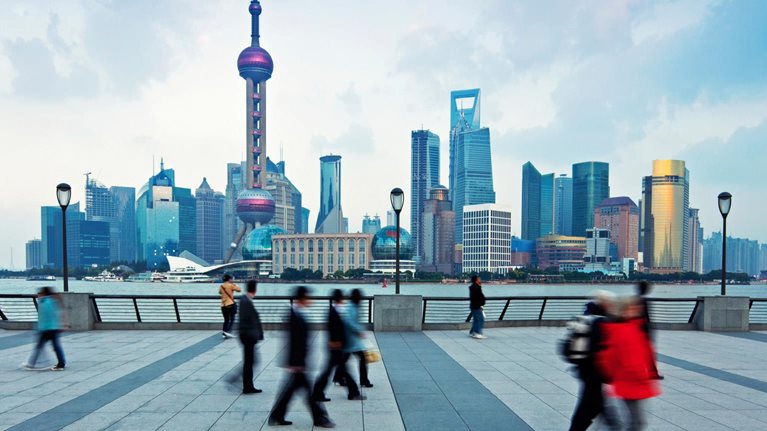The explosive growth of China’s emerging middle class has brought sweeping economic change and social transformation—and it’s not over yet. By 2022, our research suggests, more than 75 percent of China’s urban consumers will earn 60,000 to 229,000 renminbi ($9,000 to $34,000) a year.1
In purchasing-power-parity terms, that range is between the average income of Brazil and Italy. Just 4 percent of urban Chinese households were within it in 2000—but 68 percent were in 2012.2 In the decade ahead, the middle class’s continued expansion will be powered by labor-market and policy initiatives that push wages up, financial reforms that stimulate employment and income growth, and the rising role of private enterprise, which should encourage productivity and help more income accrue to households.3 Should all this play out as expected, urban-household income will at least double by 2022.
Beneath the topline figures are significant shifts in consumption dynamics, which we have been tracking since 2005 using a combination of questionnaires and in-depth interviews to create a detailed portrait by income level, age profile, geographic location, and shopping behavior.4 Our latest research suggests that within the burgeoning middle class, the upper middle class is poised to become the principal engine of consumer spending over the next decade.
As that happens, a new, more globally minded generation of Chinese will exercise disproportionate influence in the market. Middle-class growth will be stronger in smaller, inland cities than in the urban strongholds of the eastern seaboard. And the Internet’s consumer impact will continue to expand. Already, 68 percent of the middle class has access to it, compared with 57 percent of the total urban population (see “China's e-tail revolution”).
Importance of the ‘upper’ cut
The evolution of the middle class means that sophisticated and seasoned shoppers—those able and willing to pay a premium for quality and to consider discretionary goods and not just basic necessities—will soon emerge as the dominant force. To underscore this group’s growing importance, we have described it in past research as the “new mainstream.”5 For the sake of simplicity, we now call consumers with household incomes in the 106,000 to 229,000 renminbi range upper middle class. In 2012, this segment, accounting for just 14 percent of urban households, was dwarfed by the mass middle class, with household incomes from 60,000 to 106,000 renminbi. By 2022, we estimate, the upper middle class will account for 54 percent of urban households and 56 percent of urban private consumption. The mass middle will dwindle to 22 percent of urban households (Exhibit 1).
The magnitude of China’s middle-class growth is transforming the nation.

The behavior of today’s upper middle class provides some clues to China’s future. Our research indicates that these consumers are more likely to buy laptops, digital cameras, and specialized household items, such as laundry softeners (purchased by 56 percent of the upper-middle-class consumers we surveyed last year, compared with just 36 percent of the mass middle). Along with affluent and ultrawealthy consumers, upper-middle-class ones are stimulating rapid growth in luxury-goods consumption, which has surged at rates of 16 to 20 percent per annum for the past four years. By 2015, barring unforeseen events, more than one-third of the money spent around the world on high-end bags, shoes, watches, jewelry, and ready-to-wear clothing will come from Chinese consumers in the domestic market or outside the mainland.
Generation 2 comes of age
China’s new middle class also divides into different generations, the most striking of which we call Generation 2 (G2). It comprised nearly 200 million consumers in 2012 and accounted for 15 percent of urban consumption. In ten years’ time, their share of urban consumer demand should more than double, to 35 percent. By then, G2 consumers will be almost three times as numerous as the baby-boomer population that has been shaping US consumption for years.
These G2 consumers today are typically teenagers and people in their early 20s, born after the mid-1980s and raised in a period of relative abundance. Their parents, who lived through years of shortage, focused primarily on building economic security. But many G2 consumers were born after Deng Xiaoping’s visit to the southern region—the beginning of a new era of economic reform and of China’s opening up to the world. They are confident, independent minded, and determined to display that independence through their consumption. Most of them are the only children in their families because when they were born, the government was starting to enforce its one-child policy quite strictly.
McKinsey research has shown that this generation of Chinese consumers is the most Westernized to date. Prone to regard expensive products as intrinsically better than less expensive ones, they are happy to try new things, such as personal digital gadgetry. They are also more likely than previous generations to check the Internet for other people’s usage experiences or comments. These consumers seek emotional satisfaction through better taste or higher status, are loyal to the brands they trust, and prefer niche over mass brands (Exhibit 2). Teenage members of this cohort already have a big influence on decisions about family purchases, according to our research.
Generation 2—Chinese consumers in their teens and early 20s—takes a more Western approach to shopping.

Even as the G2 cohort reshapes Chinese consumption patterns, it appears to be maintaining continuity with some of the previous generations’ values. Many G2 consumers share with their parents and grandparents a bias for saving, an aversion to borrowing, a determination to work hard, and a definition of success in terms of money, power, and social status. For the G2 cohort, however, continuity in values doesn’t translate into similar consumer behavior. Likewise, 25- to 44-year-old G1 consumers, despite their loyalty to established brands, are more open than their parents to a variety of schools of thought, and as retirees in the years ahead they will certainly demonstrate a “younger” consumption mind-set than today’s elderly do.
The rise of the west (and the north)
In 2002, 40 percent of China’s relatively small urban middle class lived in the four Tier-one cities: Beijing, Shanghai, Guangzhou, and Shenzhen. By 2022, the share of those megacities will probably fall to about 16 percent (Exhibit 3). They won’t be shrinking, of course; rather, middle-class growth rates will be far greater in the smaller cities of the north and west. Many are classified as Tier-three cities, whose share of China’s upper-middle-class households should reach more than 30 percent by 2022, up from 15 percent in 2002.
The geographic center of middle-class growth is shifting.

Tier-four cities, smaller still, will also be part of that geographic transition. Consider Jiaohe, in Jilin Province. This northern inland Tier-four city is growing quickly because of its position as a transportation center at the heart of the northeast Asian economic zone, an abundance of natural resources (such as Chinese forest herbs and edible fungi), and the fact that it is one of China’s most important production bases for grape and rice wine. In 2000, less than 1,000 households out of 70,000 were middle class, but by 2022, those figures are set to rise to 90,000 and 160,000, respectively.
Another Tier-four city, Wuwei, in Gansu Province, is growing rapidly because it’s within the Jinchang–Wuwei regional-development zone and at the junction of two railways and several highways. Wuwei too had less than 1,000 middle-class households (out of 87,000 total) in 2000. By 2022, though, 390,000 of the city’s 650,000 households should be middle class.
Continued strong growth in the size and diversity of China’s middle class will create new market opportunities for both domestic and international companies. Yet strategies that succeeded in the past, given the wide distribution of standardized products for mass consumers, must be adjusted in a new environment with millions of Chinese trading up and becoming more picky in their tastes. A detailed understanding of what consumers are doing, how their preferences are evolving, and the underlying reasons for their behavior will be needed.
Armed with better information, companies can begin tailoring their product portfolios to the needs of increasingly sophisticated consumers and revising brand architectures to differentiate offerings and attract younger consumers eager for fresh buying experiences. There will be not only challenges but also plenty of opportunities for companies whose strategies reflect China’s new constellation of rising incomes, shifting urban landscapes, and generational change.


